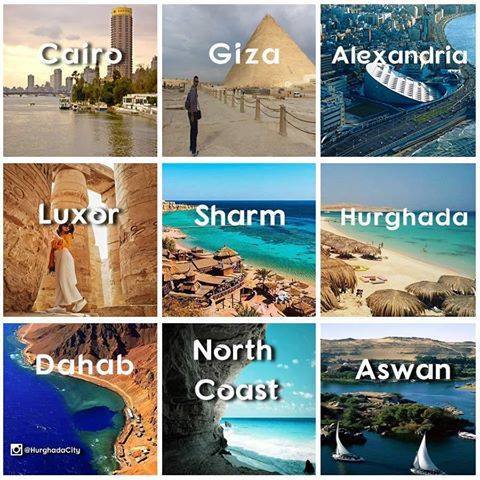Where to Go in Egypt
Egypt Tour begins at Cairo, an exploding metropolis which somehow preserves within it the finest medieval city in the world, and which since its founding by the Arabs over a thousand years ago has been Egypt’s capital.
Cairo & Giza
Egypt’s first pharaohs ruled from nearby Memphis; the grandest monuments of the Old Kingdom, the pyramids at Giza and Saqqara, still inspire awe today. The guide then heads southwards, first to the Fayyum, then upriver into Upper Egypt, following the Nile valley to Amarna where the New Kingdom heretic Akhenaten built his capital; to Abydos, the spiritual centre of Egypt, sacred to Osiris; and to the temple of Hathor at Dendera.
Upper Egypt
Beyond these lies Luxor, site of ancient Thebes, the opulent cosmopolis of Egypt’s New Kingdom pharaohs. It encompasses the grandiose temples of Luxor and Karnak on the east bank, and a vast necropolis on the west bank of the Nile, including the magnificent mortuary temple of Hatshepsut at Deir el Bahri, the tombs of the nobles and the queens, and the Valley of the Kings. Farther upriver stand the Ptolemaic temples at Esna, Edfu and Kom Ombo, and then comes Aswan, one of the most beautiful places in Egypt, where the island temple of Isis at nearby Philae is also Ptolemaic. Farther south still, like a highwater mark of New Kingdom power, are the temples built by Ramses II at Abu Simbel near the Sudan border.
The Western Desert & Red Sea
With Upper Egypt thoroughly explored, the guide then sweeps through the Western Desert, the antithesis both in mind and landscape to the yielding river valley. Calling first at the outer oasis of Siwa, it then follows the arc of the inner oases from south to north, Kharga, Dakhla, Farafra, and Bahariya. Next come the monasteries, the world’s oldest, in the Wadi Natrun between Cairo and Alexandria, and the Mediterranean coast. More monasteries, reef diving, off-road adventures and the sight of ships sailing through the desert are further wonders to be found in the Sinai, Red Sea coast and Suez Canal chapters. Finally, the guide reaches Lower Egypt where the Nile fans out to form the Delta, where, except at a few sites such as Tanis, the river’s mud has swallowed almost all tangible traces of its past. The guide ends with Alexandria, the city’s European heritage and its Mediterranean gaze giving it an atmosphere unlike any place else in Egypt.
Read More




